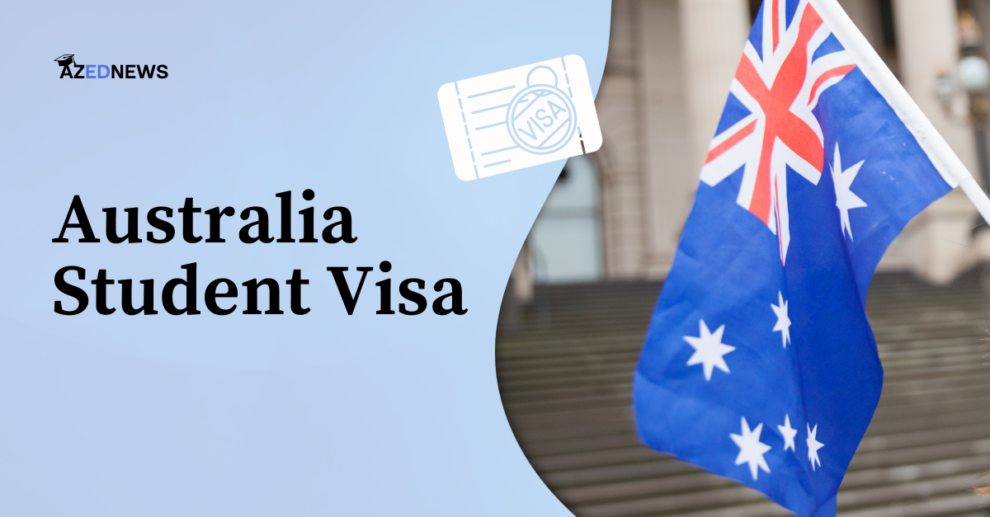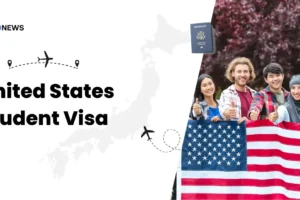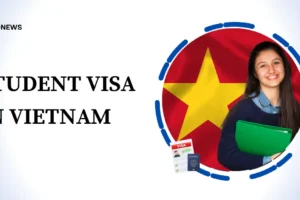Are you searching for detailed information for an Australia Student Visa? then you are on the right article. With a population of over 25 million, Australia is a very diverse country. Its origins as an Aboriginal people and a fusion of various cultures form the foundation of its unique history and culture.
Table of Contents
The nation is well-known as a top study destination for international students and a global leader in education. Australia’s reputation for education is well-known and unwavering worldwide.
They continue to have high rates of literacy and education and have one of the highest percentages of people qualified for higher education in the world. Australia is also pleased with the significant contribution it has made to international research and is home to the eight esteemed research-focused Group of Eight Universities.
Key Takeaways:
- Many students prefer studying in Australia since there are various benefits such as post-study work permits, affordable cost of living, etc.
- There are two intakes in Australia every year. One happens in February and the other starts in July.
- There are 3 types of Australian student visas.
- Students have to apply for a student visa at least 90 days before the commencement of their studies.
- To be eligible for an Australian Student visa, students have to have a confirmation of admission from an Australian university, have financial capacity, and many others.
- The Australian Student Visa application process is quite simple and quick.
- Often, the Australian Student Visa takes up to 85 days to get processed.
- Students can work for up to 40 hours every week under visa subclass 500.
Benefits of Studying in Australia:
- Top cities for students
- post-study labor permit
- Lively and diverse student life
- Simple and reasonably priced cost of life
- Absence of a language barrier
Other benefits for International students include:
| Higher Study Options | Part-time work duration allowed | Post-study work permit | Can departments work full-time? | Is schooling free for department children? | PR option available for post-study and work |
| Bachelors | 20 Hours per week | 2 Years | Yes | No | yes |
| Masters (MS/MBA) | 20 Hours per week | 3 Years | Yes | No | yes |
Intakes in Australia:
Australia has two intakes every year. They are:
- Intake 1: This commences in February and is the major intake of the year
- Intake 2: This commences in July.
However, many Australian universities offer multiple intakes even in September and November. Hence, it is often advised to start the admission process around six months before the application deadline.
| Higher Study Options | Duration | Intake months | Deadline to Apply |
| Bachelors | 3-4 years | Feb, July (Major) & Nov (Minor) | 4-6 months before the intake month |
| Masters (MS/MBA) | 1.5 – 2 years | Feb, July (Major) & Nov (Minor) | 4-6 months before the intake month |
Types of Australia Student Visa:
Australia offers visas for tons of purposes. Some of the common types of visas are:
1. Student visa or Subclass 500:
International students may undertake full-time study at accredited Australian educational institutions under the terms of the 2022 regulations. The offerings are extensive and comprise English language classes, higher education, and vocational education and training. During a semester, the visa permits working rights; during scheduled breaks, it authorizes limited work hours. The length of the course determines the duration of the visa.
2. Student guardian visa or Subclass 590:
This visa is intended for parents or legal guardians of foreign students studying in Australia who are under the age of eighteen. With the help of this visa, guardians can travel with their wards and offer assistance and support while in school. Being at least 21 years old, having sufficient financial resources, and fulfilling certain health and character requirements are the qualifications for eligibility.
Usually, the visa lasts for the term of the student’s visa or until the student turns eighteen. This visa permits limited study but does not grant employment rights. It is necessary to have sufficient health insurance, and financial means, and to comply with the visa requirements.
3. Training visa or Subclass 407:
This is a short-term visa designed for people who wish to participate in job-related training to improve their knowledge and abilities in a particular industry, profession, or area of specialization. The organized training programs offered by accredited Australian businesses, give applicants the chance to hone their abilities and get real-world experience.
This visa has multiple streams, including Occupational Training, Professional Development, and Research Activities, and it requires sponsorship from an approved organization. The length of the visa is determined by the type and level of training, and applicants must fulfill certain requirements about their educational background, fluency in English, and health insurance.
How and when to apply for an Australian student visa?
It can take up to 124 days for the Australian Student Visa application procedure to be completed before your course starts. Furthermore, you are permitted to leave for Australia up to ninety days before the commencement of your study. The following process has to be followed by the applicants:
- You must first create and log into your ImmiAccount to begin an online application.
- The visa application form for the subclass of visa under which an applicant is qualified to apply must be completed.
- You will need to sign into your ImmiAccount once more to track your application. Using your account, you may check the status of your application, attach documents, update passport information, and modify email and address details.
- Every online application is given a unique identifier known as a Transaction Reference identifier (TRN). This is necessary for managing and tracking your application, determining when to get in touch with the visa center, and verifying your eligibility for a visa.
What are the eligibility criteria for an Australian student visa?
To be eligible for an Australian student visa, a few requirements and prerequisites must be satisfied. The following are the primary prerequisites:
- Confirmation of Enrollment (CoE): A legitimate CoE from an Australian educational institution is required. Your acceptance into a registered course of study is verified by the CoE.
- Genuine Temporary Entrant (GTE) requirement: You must provide proof that your stay in Australia is entirely for academic reasons and that, after your studies are over, you plan to return home.
- Financial capacity: You must provide proof that you have enough money to pay for your living expenses, tuition, and other associated expenditures for the course of your studies.
- English Language Proficiency: Tests like the IELTS, TOEFL, or PTE Academic may be required of you, depending on your course and educational institution, as proof of your English language proficiency.
- Character and health standards: To prove you meet the nation’s health requirements, you will need to go through a medical examination. A police clearance certificate or proof of good character is also required.
- Overseas Student Health Cover (OSHC): For the length of their stay in Australia, international students are required to carry this type of health insurance.
- Real access to finances: You must show that you have the financial means to maintain yourself and any family members who are traveling with you.
- Genuine Temporary Entrant (GTE) requirement: You have to submit a statement outlining your intent to abide by the terms of your visa and why you are studying in Australia.
What are the documents required for an Australian Student Visa?
The following are some frequently needed paperwork for an Australian student visa:
- Reliable Enrollment Confirmation (CoE)
- Authentic Temporary Entrant (GTE) declaration
- Legitimate passport
- Filled out an application for a visa
- Results of an English Language Competency Test
- Monetary records
- Health coverage (OSHC, or Overseas Student Health Coverage)
- Academic records, including degrees, certificates, and transcripts
- Character documents (police clearance certificates) and the Statement of Purpose
- Biometric information (photos, fingerprints) specific to some ethnicities
What is the process for an Australian Student Visa?
Australia student visa application is often done online through the official Australian Department of Home Affairs website.
Since the visa application process takes about 124 days, you should submit your application at least three months before the start of the course. Take into account any other elements, such as holidays or busy application seasons, that can impact the time it takes to obtain an Australia student visa.
Additionally, confirm that your Confirmation of Enrollment (CoE) is valid and covers the entire course period. The following is a step-by-step guide to applying for an Australia student visa:
- Research and choose a program of study and a school that is approved and acknowledged by the Australian government.
- Verify and meet the admission standards such as academic requirements, English language skills, and any other special prerequisites imposed by the educational institution to which you are applying.
- Get the Confirmation of Enrollment (CoE) document from the educational institution as soon as you are accepted into the course. This document is necessary for your visa application.
- Get the paperwork ready for the application.
- On the Australian Department of Home Affairs official website, create an ImmiAccount and fill out the online application for the student visa (Subclass 500). Give precise and comprehensive information.
- Make the necessary online payment via the ImmiAccount portal to apply for a visa.
- Depending on where you live and how long you’re staying, you might have to go through a medical examination. You’ll get directions on how to finish this procedure.
- Make sure all the documents are in the correct format and fulfill the requirements before uploading and submitting the application.
- You might be asked to provide biometric information such as photos and fingerprints at a prearranged location, depending on your country of origin. Observe the guidelines on your application and the official website.
- You can monitor the status of your application using your ImmiAccount. Any requests for more information or documentation from the Department of Home Affairs should be answered right away.
Australia student visa fees and cost:
| Visa subclass | Base application charge | Additional applicant charge | Additional applicant charge under 18 | Subsequent temporary application charge |
| Student visa (subclass 500) | AUD650 | AUD485 | AUD160 | AUD700 |
| Student visa (subclass 500) (subsequent entrant) | AUD650 | AUD485 | AUD160 | AUD700 |
| Student visa (subclass 500) – Foreign Affairs or Defence sector | nil | nil | nil | nil |
| Student Guardian (subclass 590) | AUD650 | nil | nil | AUD700 |
| Student visa (subclass 500) – Postgraduate research sector | AUD650 | nil | nil | nil |
What can international students study in Australia?
International students in Australia can enroll in a variety of programs across multiple industries using the Subclass 500 student visa. The following are some of the courses and fields that fall under Subclass 500 and are open to holders of student visas:
1. Higher Education:
This includes university-level courses such as:
- Master’s degree
- Post graduate diploma
- Bachelor’s degree
- Doctoral Degree
2. Vocational Education and Training:
This industry provides courses leading to certifications, diplomas, and advanced degrees that are skill- and practical-based. It includes topics about building, hospitality, business, cars, beauty, and more.
3. English language intensive courses for overseas students:
These courses, collectively referred to as ELICOS, are normally taken either before or alongside other courses to improve English language proficiency. They can be anything from longer-term courses to intense short-term programs.
4. Schools:
International students can attend both government and private elementary or secondary schools in Australia with a student visa.
5. Non-Award courses or bridging programs:
These are non-degree courses taken to further one’s career, improve one’s skills, or meet requirements for more education.
6. Foundation studies:
They give students a solid academic foundation in topics like science, maths, and English and prepare them for admission to university-level courses.
What is the processing time for an Australian Student visa?
The processing time for an Australia Student Visa primarily depends on various factors such as the type of visa, country of application, and volume of applications received.
| Visa Category | Visa Process Completion up to 25% | Visa Process Completion up to 50% | Visa Process Completion up to 75% | Visa Process Completion up to 90% |
| Student Visa (Subclass 500) Foreign Affairs | 7 days | 14 days | 48 days | 85 days |
| Student Visa (Subclass 500)Postgraduate Research Sector | 18 days | 63 days | 85 days | 547 days |
| Student Visa (Subclass 500)Independent ELICOS sector | 20 days | 29 days | 44 days | 78 days |
| Student Visa (subclass 500)School Sector | 14 days | 29 days | 70 days | 121 days |
| Student Visa (Subclass 500) Vocational Education & Training | 33 days | 54 days | 213 days | 365 days |
| Student Visa (Subclass 500) Higher Education | 16 days | 29 days | 57 days | 213 days |
| Student Visa (Subclass 500) No-Award Sector | 9 days | 17 days | 23 days | 42 days |
How to prepare for an Australian Student visa?
The Australian Student Visa interview is an important part of the visa application process. It is a great opportunity for immigration officers to assess the suitability of the student to study in Australia.
Preparing efficiently for the interview can potentially increase the chances of access for students. Some tips that could help applicants are:
1. Carry out a thorough research on the visa interview process:
Become familiar with the Australian student visa interview process. Recognize the goal of the interview, the kinds of questions that might be asked, and the appropriate behavior expected of you.
2. Understand the course and institution:
Learn everything there is to know about the degree for which you have applied and the university you intend to attend. Prepare to talk about your reasons for selecting that specific course, how it fits into your academic objectives, and why you chose that particular university.
3. Express your study plans precisely:
Write a detailed and understandable description of your plans to study in Australia. Talk about the length of the course you plan to take, your interests in particular areas, and how your education in Australia will help you achieve your job aspirations in the future.
4. Prove your financial stability:
Prepare to present proof of your ability to pay for your education and to remain in Australia. Get the necessary paperwork together, such as bank statements, loan acceptance letters, or scholarship offers, to show that you have the money to pay for your living expenses, tuition, and other obligations.
5. Understand your Statement of Purpose:
Based on the details in your Statement of Purpose, the immigration officials could ask questions (SOP). Go over your SOP carefully, and be ready to discuss your career goals, the reasons you want to study in Australia, and how the course you have chosen will help you reach them.
6. Practice mock interviews:
To replicate the interview process for a visa, practice with a friend or relative. This will boost your self-assurance, sharpen your communication abilities, and have you ready to respond intelligently to inquiries.
7. Be confident and answer honestly:
Keep your composure and be calm during the interview. Pay close attention to the questions asked, then boldly and truthfully respond to them. When appropriate, cite specific instances or experiences to back up your responses.
8. Address the potential concerns:
Be ready to address any potential issues you foresee in your visa application, such as gaps in your academic record or changes in your job route. To help clear the officials’ concerns, offer rational and concise explanations.
What is the validity of an Australia student visa?
| Course Duration | Visa Validity |
| Longer than 10 months and ends in November/ December | Till March 15 of the following year. |
| Longer than 10 months but finishing between January and October | Your visa would be valid for two months longer than the duration of your course. |
| 10 months or less | Your visa will be valid for one month longer than the duration of your course. |
What is the minimum IELTS band required for an Australian student visa?
Those who want to study overseas should know that although your IELTS score is a university requirement, it does not affect your ability to obtain an Australian student visa.
The highest band needed on the IELTS for undergraduate admissions to Australia should be 6.0, with no band below 5.5; for postgraduate courses, the highest band needed to obtain a student visa is between 6.5 and 7.0.
Therefore, to be admitted to an Australian university, applicants must typically have an overall band score of 6.5 for postgraduate programs and an overall band score of 6.5 for undergraduate programs, with no component band score below 6. Certain programs, such as those in law, science, nursing, etc., have higher IELTS band requirements.
Applicants should be aware that the IELTS Band score is merely a guideline, and the actual value may vary based on the university of their choice. There are plenty of universities where students can study in Australia without IELTS. However, your Australian Student Visa is unaffected in any way by your IELTS result.
What are the part-time work options under Student Visa Subclass 500?
For students traveling to Australia, the regulations for part-time employment have not changed. When the course is in session, students may work up to 40 hours per week under Visa Subclass 500. During breaks, they may work an unlimited number of hours.
A few points to keep in mind are:
- Before the session starts, students cannot begin working.
- This restriction does not apply if casework is a required component of the course you are enrolled in. Usually, this is true for integrated courses or required internships.
- Additionally, once the research project or doctoral thesis gets underway, students in the Post Graduate Research Sector are free to work as many hours as they like. Additionally, the student may work following the previously stated 40 hours per fortnight guideline if they have registered in any preparatory courses.
- Under the Graduate Stream, students who have fulfilled the Australian study requirement may apply for a Post-study Work Permit. Nevertheless, participants in an ELICOS are not eligible to apply for a post-study work permit for Australia.
What is the eligibility to study in Australia?
The following table contains information on the educational requirements, the percentage necessary, IELTS/TOEFL/PTE score requirements, and other prerequisites for those interested in pursuing graduate and master’s degree programs in Australia.
| Higher Study Options | Minimum Educational Requirement | Minimum Required Percentage | IELTS/PTE/TOEFL Score | Backlogs Information | Other Standardized Tests |
| Bachelors | 12 Years of Education (10+2) | 60% | Overall, 6.5 with 5.5 in each band | Up to 10 backlogs (some private hospital universities may accept more) | NA |
| Masters (MS/MBA) | 3/4 Years of Graduate Degree | 65% | Overall, 6.5 with no band less than 6 | Up to 10 backlogs (some private hospital universities may accept more) | NA |
Top universities in Australia for international students:
| Australia rank | University | World rank |
| 1 | Australian National University | 30 |
| 2 | University of Melbourne | 33 |
| 3 | University of Sydney | 41 |
| 4 | University of New South Wales | 45 |
| 5 | University of Queensland | 50 |
| 6 | Monash University | 57 |
| 7 | University of Western Australia | 90 |
| 8 | University of Adelaide | 109 |
| 9 | University of Technology Sydney | 137 |
| 10 | University of Wollongong | 185 |
| 11 | RMIT University | 190 |
| 12 | University of Newcastle | 192 |
| 13 | Curtin University | 193 |
| 14 | Macquarie University | 195 |
| 15 | Queensland University of Technology | 222 |
Scholarships in Australia for International Students:
| Scholarship Name | Amount (per year) |
| Australian Government Research Training Program Scholarship | 40,109 AUD |
| BrokerFish International student scholarship | 1,000 AUD |
| The University of Sydney International Scholarship | 40,000 AUD |
| CQU International Student Scholarship | 15,000 AUD |
| CDU Vice-Chancellor’s International High Achievers Scholarships | 15,000 AUD |
| Macquarie Vice-Chancellor’s International Scholarships | 10,000 AUD |
| Griffith Remarkable Scholarship | 22,750 AUD |
Frequently Asked Questions:
1. How much money is required for an Australia Student Visa?
A$24,505 is the minimum bank balance needed to apply for an Australian student visa. This amount covers living expenses, one year’s worth of tuition, return travel from Australia to the home country of the student, and international student health insurance.
2. Which intake is best for Australia?
February intake. In Australia, the most significant and well-liked intake, referred to as semester 1 intake, occurs in February. International students can enroll in any of the courses offered in this intake.
3. Is a GTE interview mandatory in Australia?
To apply for and obtain an Australian student visa, international students must pass an integrity exam. The purpose of the Australia genuine temporary entrant form is to show that you want to visit Australia for a short time to pursue your studies.
4. Can I study in Australia without IELTS?
You certainly can! Although many colleges demand the IELTS, there are other ways to prove your English language skills. The TOEFL is one of the alternate English proficiency exams that colleges accept.
Conclusion:
Study in a nation that has generated more than 2.5 million graduates worldwide and has raised the bar for international education. Aim for top-notch, internationally recognized degrees from renowned universities. Improve your chances of landing a job by obtaining practical experience in the field through internships and placements. You may also network with international businesses and thrive in the global workforce.
High-paying professional opportunities in fields like teaching, social work, finance, IT, mining and other engineering trades, and medicine and healthcare are available to international students. Australians have one of the greatest standards of living in the world because of their strong economy, high employment rate, and high-quality work opportunities.












Add Comment